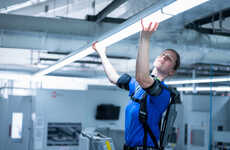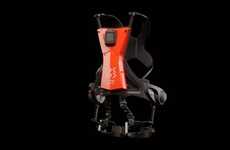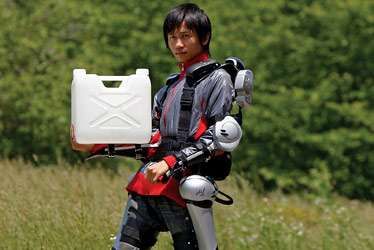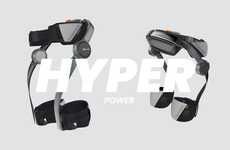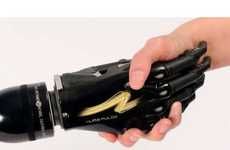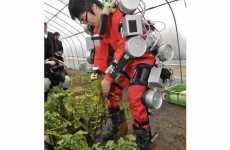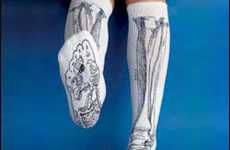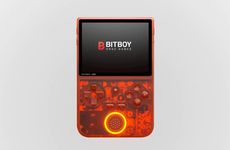
Mike Weldon — January 1, 2006 — Tech
References:
A new robot suit can help your grandma live her dreams of wanting to be a cyborg. Invented by Yoshiyuki Sankai from the University of Tsukuba
From the Japan Times:
TSUKUBA, Ibaraki Pref. -- Scientist Yoshiyuki Sankai was fascinated in his childhood by robots depicted in the U.S. literary classic "I, Robot" as well as Japanese comic books such as "Cyborg 009" and "Tetsujin No. 28."
Now he has become the creator of one of the world's most advanced robotic technologies: a robot suit.
The lower-body suit, called Hybrid Assistive Limb-3, is designed to help disabled or elderly people smoothly perform everyday activities such as walking and climbing up and down stairs. It will go on sale later this year as the world's first commercial product of its kind.
"As a child, I was thrilled at the possibility that machines can help people expand their (physical) abilities, and I still have that feeling," said Sankai, 46, a professor at the University of Tsukuba's institute of systems and engineering mechanics. "As a researcher, I have been working on projects to study how to supplement weakened human functions by (using) machines."
From Time:
Mecha-Grandma! Japanese researchers have developed a robotic exoskeleton to help the elderly and disabled walk and even lift heavy objects like the jug of water above. It's called the Hybrid Assistive Limb, or HAL. (The inventor has obviously never seen 2001: A Space Odyssey.) Its brain is a computer (housed in a backpack) that learns to mimic the wearer's gait and posture; bioelectric sensors pick up signals transmitted from the brain to the muscles, so it can anticipate movements the moment the wearer thinks of them. A commercial version is in the works. Just don't let it near the pod-bay doors.
From the Japan Times:
TSUKUBA, Ibaraki Pref. -- Scientist Yoshiyuki Sankai was fascinated in his childhood by robots depicted in the U.S. literary classic "I, Robot" as well as Japanese comic books such as "Cyborg 009" and "Tetsujin No. 28."
Now he has become the creator of one of the world's most advanced robotic technologies: a robot suit.
The lower-body suit, called Hybrid Assistive Limb-3, is designed to help disabled or elderly people smoothly perform everyday activities such as walking and climbing up and down stairs. It will go on sale later this year as the world's first commercial product of its kind.
"As a child, I was thrilled at the possibility that machines can help people expand their (physical) abilities, and I still have that feeling," said Sankai, 46, a professor at the University of Tsukuba's institute of systems and engineering mechanics. "As a researcher, I have been working on projects to study how to supplement weakened human functions by (using) machines."
From Time:
Mecha-Grandma! Japanese researchers have developed a robotic exoskeleton to help the elderly and disabled walk and even lift heavy objects like the jug of water above. It's called the Hybrid Assistive Limb, or HAL. (The inventor has obviously never seen 2001: A Space Odyssey.) Its brain is a computer (housed in a backpack) that learns to mimic the wearer's gait and posture; bioelectric sensors pick up signals transmitted from the brain to the muscles, so it can anticipate movements the moment the wearer thinks of them. A commercial version is in the works. Just don't let it near the pod-bay doors.
Trend Themes
1. Robotic Exoskeletons for Elderly Assistance - The development of robotic exoskeletons for elderly assistance presents innovative opportunities for technology to supplement weakened human functions by using machines.
2. Hybrid Assistive Limb in Commercial Market - The release of the Hybrid Assistive Limb-3 as the world's first commercial product of its kind presents an opportunity for industries to delve deeper into robotic systems that blend with human anatomy.
3. Development of Brain-computer Interface - The brain-computer interface of the Hybrid Assistive Limb presents space for industries to explore further development of areas where human and machine can interact in a seamless manner.
Industry Implications
1. Robotics Industry - The robotics industry can leverage robotic exoskeletons for elderly assistance as a disruptive innovation and focus on blending technology with human anatomy in a compliant manner.
2. Healthcare Industry - The development of robotic exoskeletons for elderly assistance could present an innovative opportunity for the healthcare industry to provide superior elderly care.
3. Technology Industry - The development of brain-computer interface of Hybrid Assistive Limb presents an opportunity for innovation in the technology industry towards exploring further integration between human and machine.
4.9
Score
Popularity
Activity
Freshness




